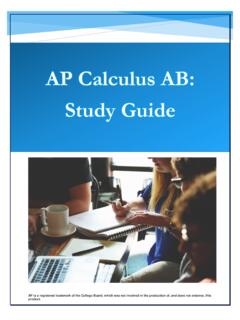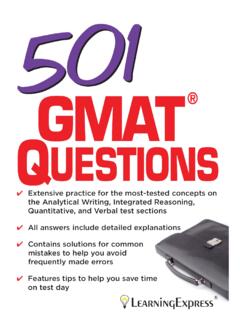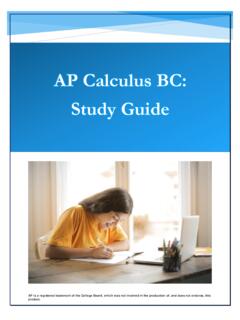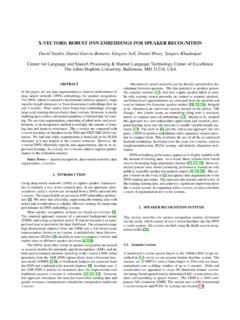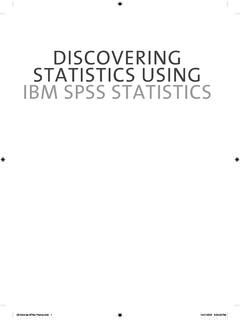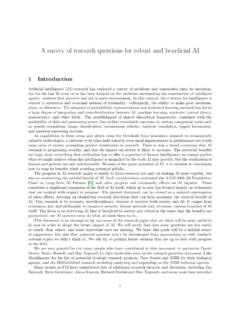Transcription of AP Statistics: Study Guide - EBSCO Connect
1 AP statistics : Study Guide AP is a registered trademark of College Board, which was not involved in the production of, and does not endorse, this product. Key Exam Details The AP statistics course is equivalent to a first-semester, college-level class in statistics . The 3-hour, end-of-course exam is comprised of 46 questions, including 40 multiple-choice questions (50% of the exam) and 6 free-response questions (50% of the exam). The exam covers the following course content categories: Exploring One-Variable Data: 15% 23% of test questions Exploring Two-Variable Data: 5% 7% of test questions Collecting Data: 12% 15% of test questions Probability, Random Variables, and Probability Distributions: 10% 20% of test questions Sampling Distributions: 7% 12% of test questions Inference for Categorical Data: Proportions: 12% 15% of test questions Inference for Quantitative Data: Means: 10% 18% of test questions Inference for Categorical Data: Chi-Square: 2% 5% of test questions Inference for Quantitative Data: Slopes: 2% 5% of test questions This Guide will offer an overview of the main tested subjects, along with sample AP multiple-choice questions that look like the questions you ll see on test day.
2 Exploring One-Variable Data On your AP exam, 15 23% of questions will fall under the topic of Exploring One-Variable Data. Variables and Frequency Tables A variable is a characteristic or quantity that potentially differs between individuals in a group. A categorical variable is one that that classifies an individual by group or category, while a quantitative variable takes on a numerical value that can be measured. 1 Examples of Variables Categorical variables The country in which a product is manufactured The political party with which a person is affiliated The color of a car Quantitative variables The height, in inches, of a person The number of red cars that pass through an intersection in a day It is important to recognize that it is possible for a categorical variable to look, superficially, like a number.
3 For example, despite being composed of numbers, a zip code is categorical data. It does not represent any quantity or count; rather, it s simply a label for a location. Quantitative variables can be further classified as discrete or continuous. A discrete variable can take on only countably many values. The number of possible values is either finite or countably infinite. In contrast, a continuous variable can take on uncountably many values. An important characteristic of a continuous variable is that between any two possible values another value can be found. Graphs for Categorical Variables A categorical variable can be represented in a frequency table, which shows how many individual items in a population fall into each category. For example, suppose a student was interested in which color of car is most popular. He collects data from the parking lot at school, and his results are shown in the following frequency table: Color Frequency Black 14 Red 6 Blue 5 Silver 11 White 6 Green 3 Yellow 1 Grey 4 2 A relative frequency table gives the proportion of the total that is accounted for by each category.
4 For example, in the previous data, 14 of the 50 cars, or 28%, were black. The full relative frequency table is as follows: Color Relative Frequency Black 28% Red 12% Blue 10% Silver 22% White 12% Green 6% Yellow 2% Grey 8% Note that the percentages add up to 100%, since all of the cars were of one of the colors represented in the table. A bar chart is a graph that represents the frequencies, or relative frequencies, of a categorical variable. The categories are organized along a horizontal axis, with a bar rising above each category. The height of the bar corresponds to the number of observations of that category. The vertical axis may be labeled with frequencies or with relative frequencies, as in the following examples. A bar chart representing data from more than one set is useful for comparing the frequencies across the sets. For example, suppose that the day after collecting the initial data on car colors, the student collected the same information from a parking lot at a nearby school.
5 The results can be compared using the following bar chart, which shows the relative frequencies for each color, separated by school: 3 Graphs for Quantitative Variables A histogram is related to a bar chart but is used for quantitative data. The data is split into intervals, or bins, and the number of data points in each interval is counted. The horizontal axis contains the different intervals, which are adjacent to each other, as they form a number line. The vertical axis shows the count for each interval. The following histogram represents the scores that 50 students received on a test: How the data is split into intervals can have a big impact on the appearance of the histogram. Two histograms that represent the same data can show different characteristics, depending on the choice of interval width.
6 4 A stem-and-leaf plot is another graphical representation of a quantitative variable. Each data value is split into a stem (one or more digits) and a leaf (the last digit). The stems are arranged in a column, and the leaves are listed alongside the stem to which they belong. The test score data is shown in the following stem-and-leaf plot: 4 9 5 1 3 5 5 6 9 9 0 6 0 1 3 3 3 4 4 5 6 8 8 8 9 7 1 1 2 2 4 5 5 5 6 6 7 7 8 9 8 0 0 2 2 3 3 3 5 5 6 7 7 7 8 In a dotplot, each data value is represented by a dot placed above a horizontal axis.
7 The height of a column of dots shows how many repetitions there are of that value. The following is a subset of the test score data: The Distribution of a Quantitative Variable The distribution of quantitative data is described by reference to shape, center, variability, and unusual features such as outliers, clusters, and gaps. When a distribution has a longer tail on either the right or left, the distribution is said to be skewed in that direction. If the right and left sides are approximately mirror images, the distribution is symmetric. A distribution with a single peak is unimodal; if it has two distinct peaks, it is bimodal. A distribution without any noticeable peaks is uniform. An outlier is a value that is unusually large or small. A gap is a significant interval that contains no data points, and a cluster is an interval that contains a high concentration of data points. In many cases, a cluster will be surrounded by gaps.
8 5 Free Response Tip If you are asked to compare two distributions, be sure to address both their similarities and differences. For example, perhaps they are both unimodal, but one is skewed while the other is symmetric. Perhaps one has an outlier while the other does not. In particular, be sure to note if one has greater variability than the other, even if you cannot quantify the difference. Summary statistics and Outliers A statistic is a value that summarizes and is derived from a sample. Measures of center and position include the mean, median, quartiles, and percentiles.
9 The commonly used measures of variability are variance, standard deviation, range, and IQR. The mean of a sample is denoted x, and is defined as the sum of the values divided by the number of values. That is, 11niixnx== . The median is the value in the center when the data points are in order. In case the number of values is even, the median is usually taken to be the mean of the two middle values. The first quartile, 1Q, and the third quartile, 3Q, are the medians of the lower and upper halves of the data set. The ideas behind the first and third quartiles can be generalized to the notion of percentiles. The p th percentile is the data point that has p% of the data less than or equal to it. With this terminology, the first and third quartiles are the 25th and 75th percentiles, respectively. The range of a data set is the difference between the maximum and minimum values, and the interquartile range, or IQR, is the difference between the first and third quartiles.
10 That is, 31 IQQR Q= . Variance is defined in terms of the squares of the differences between the data points and the mean. More precisely, the variance s 2 is given by the formula ()22111niisxxn== . The ()2111niixsxn== .standard deviation is then simply the square root of the variance: 6 When units of measurement are changed, summary statistics behave in predictable ways that depend on the type of operation done. Statistic Original value Value after multiplying all data points by a constant c Value after adding a constant c to all data points Mean xcxxc+Median/Quartile/Percentile mcmmc+Range/IQR rcrr Variance 2s22c s2sStandard deviation scssThere are many possible ways to define an outlier.




